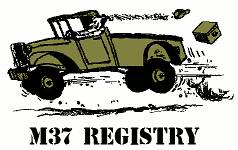Before I get into the engine stuff I wanted to thank my friends Mark and John for their help on this project and say how helpful the g741 site has been since I started playing with M37's 8 years ago. The site has provided tons of useful information and more importantly has lead to a great group of M37 friends all over the country
The engine we're rebuilding was pulled from a truck BBQ'ed in the Napa fires in '17. The rear of the truck was heated enough to warp the leaf springs so everything behind the transfer case is suspect, but the engine seemed OK. The students and I were able to get the truck running on 3 wheels and a moving dolly! The though was to see if we could just swap the BBQ'ed engine into the other M37. Once we were satisfied that it ran OK we pulled it out for examination and possible installation.
The exam didn't go as well as hoped, but it was educational for the kids! The bores were standard and the crank was .010" under. The rod journals showed signs of wear from debris and sitting so we decided that we'd begin tearing the engine down. The bores looked bad. They had major wear, but not on the thrust surfaces. Since the wear was only on the siamesed portion of the bores and not on the thrust surfaces I suspect it was run hot and the lube broke down on that area of the cylinder leading to the wear. The bores had no ridge at the top. Then we saw the #2 Intake cam lobe, it was missing a chunk! Not sure what happened there, but I'm sure happy we chose to rebuild the engine and not run it! Other that some adventures due to a broken stud (VERY educational!), the teardown went well. We now have the engine completely apart and are busy cleaning it up prior to its trip to the machine shop. The volume of "mud" in the bottom of the water jackets was impressive!!!! Hopefully we won't find any more surprises.
The plan for this engine is simple and an evolution of the last rebuild. The engine's cruising speed will be 2800RPM with a governed max of 3000RPM. This worked well with the last motor and survived a lot of miles between 55-60mph without frying the transfer case or tossing rods. We're using mostly NOS parts and will increase the performance via compression ratio, cleaning up the ports and back cutting the valves. We're going to use a small chamber 218 head again and adjust the CR by decking the block, milling the head and using a custom head gasket. The last engine had a CR of ~7.7:1 and squish of .07". This was good for ~20 lb-ft of torque throughout the operating range of the engine. I was not able to get the squish and CR I'd hoped for due to issues with decking the engine. This time around we're shooting for 8.5:1 and a squish of ~040". This should bump the power and efficiency up further and still be reliable. I have most of the parts in hand, a fresh 218 head (THANKS Mark!) and a deck plate (THANKS John!). Now it's time to get the block/head ready for the machine shop and check on the custom head gaskets.
I'd like to get this thing up and running by June, but it's been busy at home, so we'll see. I enjoy playing with these old engines and if I rebuild enough of 'em I might even learn something! Maybe one day we'll make over 60RWHP
Andy



